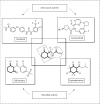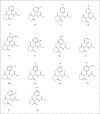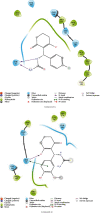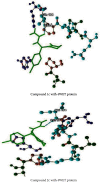Nanobased Antibacterial Drug Discovery to Treat Skin Infections o f Staphylococcus aureus Using Moringa oleifera-Assisted Zinc Oxide Nanoparticle and Molecular Simulation Study
- PMID: 35187170
- PMCID: PMC8853801
- DOI: 10.1155/2022/7228259
Nanobased Antibacterial Drug Discovery to Treat Skin Infections o f Staphylococcus aureus Using Moringa oleifera-Assisted Zinc Oxide Nanoparticle and Molecular Simulation Study
Retraction in
-
Retracted: Nanobased Antibacterial Drug Discovery to Treat Skin Infections of Staphylococcus aureus Using Moringa oleifera-Assisted Zinc Oxide Nanoparticle and Molecular Simulation Study.Biomed Res Int. 2024 Jan 9;2024:9894601. doi: 10.1155/2024/9894601. eCollection 2024. Biomed Res Int. 2024. PMID: 38230154 Free PMC article.
Abstract
In addition to the physical barrier, the epidermis acts as a natural barrier against microbial proliferation. It is prone to bacterial infections on the skin and in the nose, such as Staphylococcus aureus, as well as a variety of other skin illnesses. Green nanomaterial production, which eliminates the use of harmful chemicals while simultaneously reducing time, is gaining popularity in the nanotechnology area. Using the leaf extract of the pharmacologically valuable plant Moringa oleifera, we described a green synthesis of ZnO NPs (zinc oxide nanoparticles). ZnO NPs had a particle size of 201.6 nm and a zeta potential of -56.80 mV, respectively. A novel aminoketone antibacterial medication was synthesized and tested for antibacterial activity using ZnO NPs as a phytocatalyst in this work. This method produces high yields while maintaining efficient and gentle reaction conditions. Moringa oleifera extract can reduce ZnO to ZnO NPs in a straightforward manner. FT-IR, 1H-NMR, 13C-NMR, mass spectra, elemental analysis, and morphological analysis were used to synthesize and describe the antibacterial medicines (1a-1g) and (2a-2g). In addition, antibacterial activity was evaluated against bacteria such as Enterococcus faecalis and Staphylococcus aureus, and compound 1c (63 μg/mL, E. faecalis) and compound 2e (0.12 μg/mL, S. aureus) were found to be very active when compared to other medications. mupirocin is used as a reference. In addition, studies of in silico molecular docking for the bacterial DsbA protein were conducted. The strong molecules 1c (-4.3 kcal/mol) and 2e (-5.1 kcal/mol) exhibit a high binding affinity through hydrogen bonding, according to docking tests.
Copyright © 2022 Perumal Gobinath et al.
Conflict of interest statement
The authors declare no conflict of interest.
Figures

















References
Publication types
MeSH terms
Substances
LinkOut - more resources
Full Text Sources
Medical

